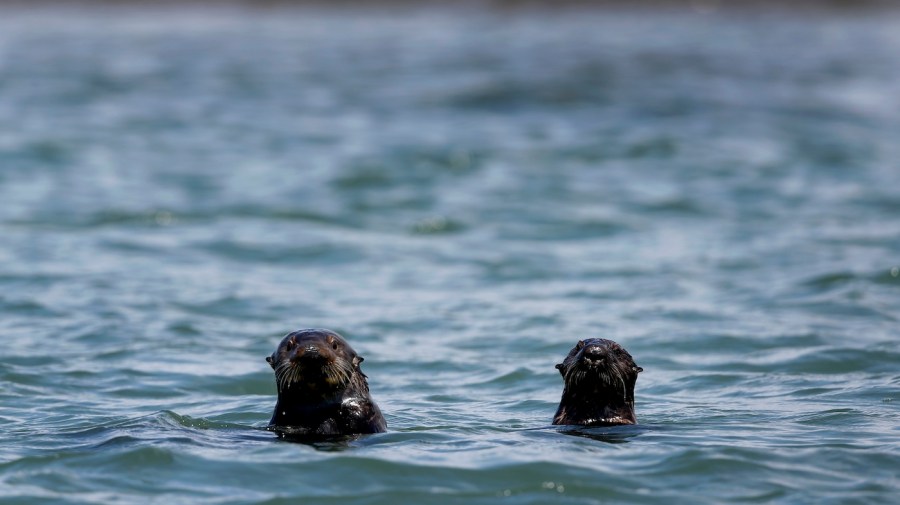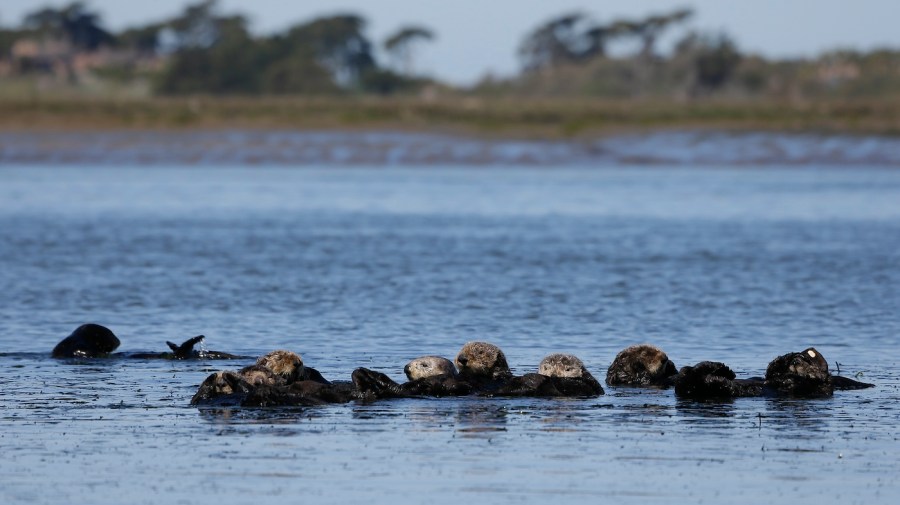In California, otters are turning to tools to eat prey in Monterey Bay
West Coast sea otters are turning to tool use to exploit richer prey and get a leg up on the competition, a new study has found.
In Monterey Bay, an incredible rebound in sea otter populations has made their favorite prey scarce — and pushed them to pursue tougher options, according to findings published Thursday in Science.
“Historically, [otters] prefer sea urchins and abalones — prey items that they don’t need tools to break open,” said lead author Chris Law, a researcher at the University of Texas at Austin.
“But those populations have declined a lot. And a lot of it has to do with the otters eating all of them.”
That decline has been in a boon for coastal ecosystems. Sea urchins are voracious consumers of kelp, the undersea algae “forests” that serve a similar function undersea to tree-based forests on land.
Otters, which eat three times as much per pound of body mass as a typical mammal their size, are “remarkably efficient predators,” said ecologist and co-author Tim Tinker of the University of California, Santa Cruz.
By eating their favored sea urchins that would otherwise graze on kelp and coastal marshes, otters have helped ease the recovery of both ecosystems, according to findings published in Nature in January.
That’s a result of a great success story in conservation, Tinker noted. To survive in the cold waters of the North Pacific, sea otters have the densest coats of any mammal: up to a million hairs per square inch, which is fifty times that of a chinchilla — or a one thousand times that of a human.
This dense fur spurred a two-century long commercial hunting spree in which trappers killed hundreds of thousands of otters — creating corporate giants like the Hudson’s Bay Company and ultimately driving the otter population of Central California down to an isolated colony of just 50 individuals.
As scientists now understand, otters are a “keystone species,” which means they have an impact on ecosystems far beyond what their numbers would usually suggest. Their decline over the past centuries set off a “cascade” as hungry sea urchins, freed of their chief predator, ate through kelp forests.
As a result, the coastal ecosystem “underwent a phase shift from kelp forests to deforested sea urchin barrens,” a 2009 paper found. As the kelp forests disappeared, numbers of filter-feeding mussels and barnacles crashed, as did populations of fish like greenlings. Bald eagles switched from a balanced diet to one exclusively composed of marine birds like gulls; gulls, in turn, switched from eating fish to invertebrates.

Sea otters swim near the shore at Elkhorn Slough in Moss Landing, Calif. on April 12, 2018. Marine biologists from the Monterey Bay Aquarium have observed that sea otters rehabilitated and released into Elkhorn Slough has helped restore eel grass beds and the ecosystem. (Photo By Paul Chinn/The San Francisco Chronicle via Getty Images)
Verge of extinction
In 1911, with otters on the verge of extinction, Congress outlawed the fur trade, and by the time it passed the Marine Mammal Protection Act in 1972, local populations had rebounded to 1,000.
Now they are closer to 3,000 — putting them somewhere close to “equilibrium” with their local prey resources, Tinker said.
Their increasingly specialized diets — an exclusive focus on either snails or clams — “and increased tool use are some of the interesting behavioral manifestations of this process” of recovery, Tinker said.
The tools in question are, in human terms, very simple: rocks, glass bottles, shells or the sides of boats or docks.
But these make an excellent anvil on which a hungry otter can smash open a clam (rare but highly-nutritious) or a sea snail (not many calories, but very common) and scoop out the tasty flesh within.
These tools have allowed the resurgent otter populations to do something that was little reported during the years when otters had an all-they-could-eat bounty of sea urchins: specialization on hard-shelled mollusks.
No one knows if this specialization — or tool use — is truly new for sea otters. “Their tools don’t really fossilize,” Law said. “So in terms of when their tools first appeared — no idea.”
“It would be super cool to find out,” he added.
Sea otters split from their freshwater relatives about 5 million years ago — about as far back as the human split from the other great apes.
It’s also not clear whether the choice to specialize in specific prey — as sea otters now do — is new. The last time sea otter populations were this high was during the height of the fur trade, and the modern study of marine ecology did not exist.
In other words, no one now alive has seen Monterey Bay when it was anything close to its carrying capacity for otters — at least, until now.
One thing, however, is clear from the research: whether it’s a new behavior or not, sea otters’ ability to tap into new resources can mean the difference between life and death as competition for their favored resources increases.
Female sea otters prone to tool use
That particularly holds true for female sea otters — who the scientists found are particularly prone to tool use.
“Females have weaker biting abilities, so they’re not able to break open harder or larger prey items,” Law said.
Tool use “really allows them to gain access to these harder larger prey items that they might not otherwise be able to access by biting alone.”
That’s important because female sea otters are also the ones that have to bear, nurse and raise the next generation.
That’s a lengthy and energetically demanding process that only ends once the pups have learned to forage for themselves — which often includes adopting whatever tool-using strategy their mother uses.
“Anything that increases feeding efficiency will really help these otters survive as well as raising pups until they are ready to leave,” Law said.
This gender disparity in tool use isn’t unique to otters. Female bonobo chimpanzees, chimps and dolphins also tend to use tools more often than their male counterparts.

Sea otters are seen together along the Elkhorn Slough in Moss Landing, Calif. on March 26, 2018. (AP Photo/Eric Risberg)
By using tools, female otters were able to crack open prey that was twice as hard as they otherwise would have been able to, the researchers found.
For males, tool use doesn’t necessarily open up new resources: their tough jaws can crack open snails or clams without help.
But it does save their teeth. Both male and female otters sustained less tooth damage when they used rocks, boats or bottles as anvils to crack open their clams or crabs — which meant fewer cracked teeth and ultimately a longer life.
This adds otters to “a growing list of examples in species” that use tools to minimize injury while hunting — like birds that drop hard-shelled prey from height to smash it open, or dolphins that use sponges as a kind of glove to protect their snouts while pulling bottom-dwelling fish out of the sand.
In broad terms, Tinker said, the otters’ recovery, and their surprising change in behavior, may hold lessons for the broad swaths of coastal California and Oregon where they have not yet recovered.
In those areas, “their ecosystem functions are still absent,” Tinker said.
“But as we look to future environmental change and the need for building resiliency in coastal ecosystems — we think sea otters can be an important part of that.”
Copyright 2023 Nexstar Media Inc. All rights reserved. This material may not be published, broadcast, rewritten, or redistributed. Regular the hill posts











